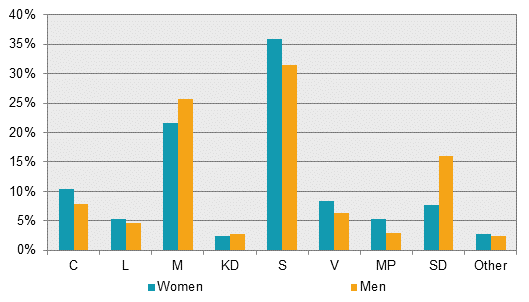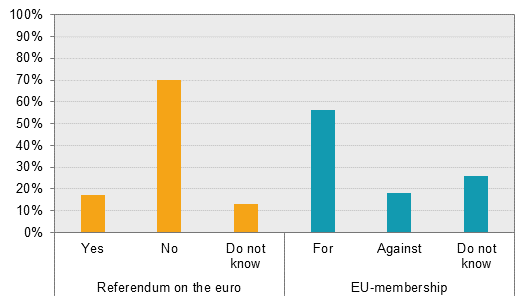Political Party Preference Survey in November 2017 – Political party preferences:
Political party preferences November 2017
Statistical news from Statistics Sweden 2017-12-08 9.30
The Political Party Preference Survey shows the support of the various parties in different demographic groups. Political party preference does not refer to any specific level of politics and no consideration is taken to whether or not a person will vote. The survey also presents the EU and euro preferences of the electorate.
On 5 December, Statistics Sweden published estimates of election results if there were to be an election in November 2017. Here we present estimates of party preferences in the electorate from the same survey.
The difference between the measurements is:
- Party preference does not refer to any specific level of politics and no consideration is taken to whether or not a person will vote. The results are weighted by region, sex, age, level of education and Swedish/foreign born.
- The “Election today” estimate refers to the results of an election in November. The results are weighted by how people voted in the previous Riksdag election as well as the question of whether a person would vote or not.
Since different methods are used for the estimations of party preference and “Election today”, comparisons should be made with caution.
The distribution of party preferences among women and men in the electorate are shown below.

| Party | Women | Men | Total | ||||
|---|---|---|---|---|---|---|---|
| Percent | Margin of error | Percent | Margin of error | Percent | Margin of error | ||
|
C
|
10.4% | ±1.4 | 7.9% | ±1.1 | 9.2% | ±0.9 | |
|
L
|
5.4% | ±1.0 | 4.6% | ±0.9 | 5.0% | ±0.7 | |
|
M
|
21.7% | ±1.9 | 25.7% | ±1.9 | 23.7% | ±1.3 | |
|
KD
|
2.5% | ±0.7 | 2.7% | ±0.7 | 2.6% | ±0.5 | |
|
S
|
35.9% | ±2.2 | 31.4% | ±2.0 | 33.6% | ±1.5 | |
|
V
|
8.3% | ±1.3 | 6.3% | ±1.0 | 7.3% | ±0.8 | |
|
MP
|
5.3% | ±1.0 | 3.0% | ±0.7 | 4.2% | ±0.6 | |
|
SD
|
7.7% | ±1.3 | 16.1% | ±1.6 | 11.9% | ±1.0 | |
|
Other
|
2.8% | ±0.8 | 2.4% | ±0.7 | 2.6% | ±0.5 | |
In the table appendix of the The Party Preference Survey in November 2017, party preference is presented for a number of different groups in the population of eligible voters for example sex, age, country of birth and level of education.
EU and euro preferences
If there were to be a referendum on the euro in November 2017, 17.1 ± 1.1 percent would vote “yes” to the euro and 69.9 ± 1.3 percent would vote “no”. 13.0 ± 1.0 percent say they do not know how they would vote. Compared with May 2017, there is no statistically significant changes.
The proportion of those who say they are mainly in favour of Sweden’s EU membership was 56.1 ± 1.4 percent in November 2017. The proportion against EU membership was 17.9 ± 1.1 percent, and the proportion that did not have an opinion was 25.9 ± 1.3 percent.
Compared with May 2017, the proportion that say they are in favour of EU membership has increased, while the proportion of those who are against membership has decreased. These changes are statistically significant.

Questions:
1. "How would you vote if there were a referendum on replacing the Swedish krona with euro today? Would you vote yes or no on the question: should Sweden introduce the euro as its official currency?"
2. "Are you principally for or against Sweden's membership in the EU or are you undecided?"
Definitions and explanations
The Party Preference Survey in November 2017 was conducted with a national random probability sample consisting of 8 919 persons entitled to vote in the Riksdag election, without an upper age limit. Answers are collected from these selected persons through telephone interviews and web questionnaires. A collection of answers through mixed mode was introduced for the first time in May 2015. The persons in the sample are offered the possibility to answer through a web questionnaire in the beginning of the collection period. If they have not replied via the web questionnaire, they have been contacted via telephone later on. As in the previous surveys, all available telephone numbers, both to mobile phones and home phones, have been used to contact the selected persons.
Of the sample persons, 23.9 percent could not be reached (including persons with unlisted telephone numbers and those without telephones), 3.1 percent were not able to participate and 20.1 percent did not want to be interviewed. The total non-response rate was 47.1 percent. The total number of respondents was 4 715. In addition, some persons did not want to answer certain questions. The data was collected during the period from 27 October to 28 November. Non-response is presented in more detail in table 23 in the table publication Party Preference Survey November 2017.
The results are presented in point estimations ± margins of error. The interval that is formed by the percent estimation ± margin of error here is a 95 percent uncertainty interval, which is an interval that with 95 percent probability includes the actual value of the population, if no systematic errors occur.
Publication
In the table appendix of the publication, results are also presented by region, foreign/Swedish background, civil status, children, income, form of housing, occupation, socio-economic group, sector and union membership.
Next publishing will be
Estimates of election results for the Riksdag election in May 2018 will be published on 5 June 2018 at 09:30.
Political party preferences and EU/euro preferences in May 2018 will be published on 11 June 2018 at 09:30.
Statistical Database
More information is available in the Statistical Database
Feel free to use the facts from this statistical news but remember to state Source: Statistics Sweden.
